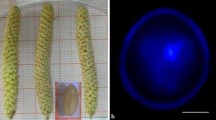The Olive (Olea europaea L.) belongs to the family Oleaceae. The leaves are opposite. The flowers are borne in racemes which emerge from the axils of the leaves, and produce large quantities of pollen. The fruit is a drupe. Olive trees grow very slowly and rarely reach more than 15 m in height, but they may have a lifespan of hundreds of years. To date, modern molecular technologies in plant breeding have not been applied extensively in olive, but using biotechnology may provide profitable results. As has been demonstrated in other crops, biotechnological methods can improve the efficiency and increase the speed of breeding. Microspore embryogenesis through in vitro culture is a widely-used method to generate genetic variability by obtaining microspore-derived embryos and double-haploid plants, with many applications for plant breeding (Chupeau et al., 1998). Gametic and haploid regenerants are also very important in breeding because the single set of chromosomes allows the isolation of mutants and the production of homozygous doubled-haploids, through chromosome doubling.
Access this chapter
Tax calculation will be finalised at checkout
Purchases are for personal use only
Preview
Unable to display preview. Download preview PDF.
Similar content being viewed by others
References
Barro, F. & Martin, A. (1999) Response of different genotypes of Brassica carinata to microspore culture. Plant Breeding 118, 79-81.
Bayliss, K.L., Wroth, J.M. & Cowling, W.A. (2004) Pro-embryos of Lupinus spp. produced from isolated microspore culture. Austr. J. Agricult. Res. 55, 589-593.
Bueno, M.A., Gómez, A., Boscaiu, M., Manzanera, J.A. & Vicente, O. (1997) Stress-induced formation of haploid plants through anther culture in cork-oak (Quercus suber L.). Physiol. Plant. 99, 335-341.
Bueno, M.A., Gómez, A. & Manzanera, J.A. (2000) Somatic and gametic Embryogenesis in Quercus suber L. In Jain, S.M., Gupta, P.K. & Newton, R.J. (Eds). Somatic Embryogenesis in Woody Plants. Forestry Sciences. Vol 6. Kluwer Academic Publishers. Dordrecht/Boston/London. ISBN 0-7923-6419-8, pp. 479-508.
Bueno, M.A. & Manzanera, J.A. (2003) Oak anther culture. In Doubled Haploid Production in Crop Plants. A Manual. Maluszynski, M., Kasha, K.J., Foster, B.P. & Szarejko, I. (Eds). Kluwer Academic Publishers, Dordrecht. ISBN 1-4020-1544-5, pp. 297-301.
Bueno, M.A., Pintos, B., Gomez, A. & Martin, A. (2004) Monitoring of in vitro cultured microspores switched to embryogenesis in Olea europaea L. Polen: Proc. XI International Palynological Congress, 14, pp. 26.
Bueno, M.A., Pintos, B., Höfer, M. & Martin, A. (2005) Pro-embryos induction from Olea europaea L. isolated microspore culture. Acta Physiol. Plant. 27, 695-701.
Chupeau, Y., Caboche, M. & Henry, Y. (1998) Androgenesis and haploid plants., Springer-Verlag, Berlin, Heidelberg.
Germana, M.A. & Chiancone, B. (2003) Improvement of the anther culture protocol in Citrus clementina Hort. ex Tan. Plant Cell Rep. 22, 181-187.
Höfer, M. (2004) In vitro androgenesis in apple - improvement of the induction phase. Plant Cell Rep. 22, 365-370.
Höfer, M., Touraev, A. & Heberle-Bors, E. (1999) Induction of embryogenesis from isolated apple microspores. Plant Cell Rep. 18, 1012-1017.
Kyo, M. & Harada, H. (1986) Control of the developmental pathway of tobacco pollen in vitro. Planta 168, 427-432.
Maluszynski, M., Kasha, K.J., Forster, B.P. & Szarejko, I. (2003) Doubled Haploid Production in Crop Plants. A Manual. Kluwer Academic Publishers, Dordrecht, Boston, London.
Touraev, A., Vicente, O. & Heberle-Bors, E. (1997) Initiation of microspore embryogenesis by stress. Trends Plant Sci. 2, 297-302.
Zaki, M.A.M. & Dickinson, H.G. (1991) Microspore-derived embryos in Brassica: the significance of division symmetry in pollen mitosis I to embryogenic development. Sex Plant Reprod. 4, 48-55.
Zheng, Y.M., Weng, Y., Liu, W. & Konzak, C.F. (2002) The effect of ovary conditioned medium on microspore embryogenesis in common wheat (Triticum aestivum L.) Plant Cell Rep. 20, 802-807.
Zheng, Y.M. (2003) Microspore culture in wheat (Triticum aestivum)-doubled haploid production via induced embryogenesis. Plant Cell Tiss. Org. Cult. 73, 213-230.
Author information
Authors and Affiliations
Editor information
Editors and Affiliations
Rights and permissions
Copyright information
© 2007 Springer
About this chapter
Cite this chapter
Pintos, B., Martin, A., Bueno, M.A. (2007). Micropropagation Protocol for Microspore Embryogenesis in Olea Europaea L. In: Jain, S.M., Häggman, H. (eds) Protocols for Micropropagation of Woody Trees and Fruits. Springer, Dordrecht. https://doi.org/10.1007/978-1-4020-6352-7_33
Download citation
DOI: https://doi.org/10.1007/978-1-4020-6352-7_33
Publisher Name: Springer, Dordrecht
Print ISBN: 978-1-4020-6351-0
Online ISBN: 978-1-4020-6352-7
eBook Packages: Biomedical and Life SciencesBiomedical and Life Sciences (R0)




